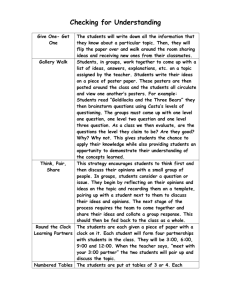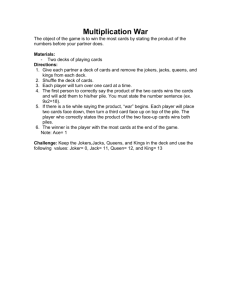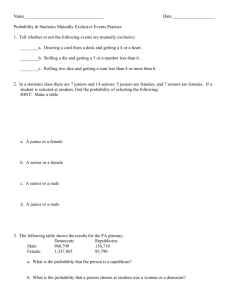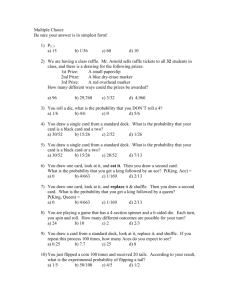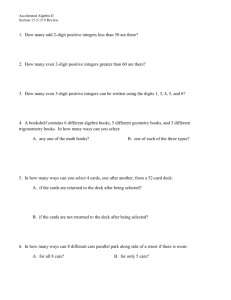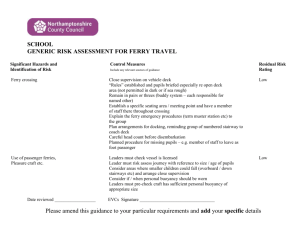Deck Installation - Barbour Product Search
advertisement
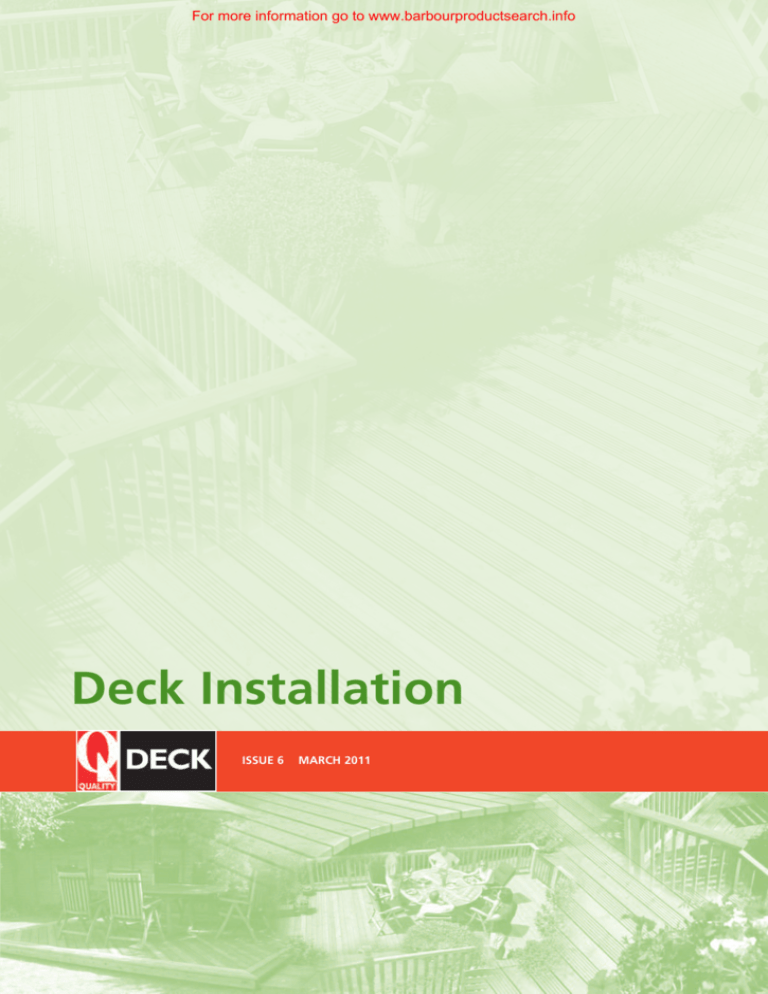
For more information go to www.barbourproductsearch.info Deck Installation ISSUE 6 MARCH 2011 PA G E For more information go to www.barbourproductsearch.info Deck Installation Contents SAFETY FIRST 2 FIXINGS 2 10 TOP TIPS 3 TECHNICAL ADVICE 4 BUILDING YOUR DECK 5 Preparing the oversite 5 5 5-6 7 7 8 8 8 9 10 11 11 12 12 13 13 Subframe Subframe examples Support posts and beams Fixing the joists Fitting newels Fitting deckboards Strategic inclusion of areas with enhanced grip Fitting Q-Deck® Lyptus deckboards Creating a border Fitting balustrades Fitting balustrades using multipurpose products Fitting balustrades using Grecian/New Contemporary columns Fitting balustrades using Super Privacy Windsor Lattice loose components Fitting balustrades using Deckorators™ Baroque balusters Steps and stairs CARE AND MAINTENANCE 14-15 CASE STUDY 16 1 For more information go to www.barbourproductsearch.info Deck Installation Installation guides Safety First ✓ ✓ ✓ ✓ ✓ ✓ ✓ ✓ When handling and processing treated timber always wear gloves and eye protection and work in a well ventilated area. Wash hands thoroughly after handling treated timber and especially before eating or smoking. Installation guides Do not burn timber off-cuts. Dispose of them safely as refuse. Treated timber contains chemical preservatives. When constructing pergolas keep the surrounding area clear of people until the structure is fully secure. Wear goggles when pressure washing or scrubbing with chemical cleaners or restorers. Keep children away from the work area until the job has been completed and tools have been stored safely. A Consumer Information sheet for TANALISED® E /TANALISED® EXTRA treated timber covering its general use is available from Arch Timber Protection - www.archtp.com. The grinding and cutting of Q-Grip® products may produce dust and loose flying particles and we strongly recommend that personnel carrying out these tasks wear suitable Personal Protective Equipment including gloves, eye protection, particulate dust mask and ear defenders. Fixings All Q-Deck® products should be fixed or secured using recognised quality products. Q-Deck® recommend the use of screws to fix deck boards and bolts or structural screws to secure newel posts or structural elements of the deck. The raw material and the type of coating used to protect these from corrosion is vital. This is why Q-Deck® recommend stainless steel fixings for the best results. If galvanised fixings are used they should be of the hot dipped variety to help avoid corrosion. Q-Deck® do not recommend deck clips or the use of pneumatic nail guns. Always follow the manufacturer’s instructions when working with deck fixings. PA G E 2 For more information go to www.barbourproductsearch.info Deck Installation 10 Top Tips & Guidance 1 2 It is advisable to loosely lay components, ie. in particular deck boards, out on the finished sub frame prior to securing them. The longer they are left to become surface dry the less the effects of shrinkage will be apparent after fixing them. The timber can also be cut and sanded more easily when dry. Fix boards with corrosion resistant screws, or for the very best results use stainless steel screws (2 screws 15-20% of its width in from each edge of the board). Structural fixtures and fittings should be specially coated or of hot dipped galvanised material - see page 2. 3 It is advisable to pre-drill pilot holes near the end of boards to avoid splitting. 4 Deck board screw length should be 21/2 times the thickness of the deck board. 5 For maximising its life it is advisable to cover fabric weed membrane with pea shingle. Some guidance to further minimise the risk of fungal decay and insect attack and thus simplify a warranty claim 6 All cut ends and notches made to the timber components must be protected with a suitable brush-on end grain preservative (eg. Ensele®/Ronseal® end grain preserver/Hickson Decor® end grain preservative) to maintain the integrity of the preservative treatment. 8 Cut the top of the support post at an angle to aid water ‘run off’. 9 If you need to attach a ledger board to the wall of a dwelling it is advisable to leave a gap between them use 10mm thick spacer/packer. This will maintain ventilation and enable the wall and ledger to dry. 10 7 Deck boards should be surface dry and laid with no less than a 6mm gap between boards (this allows for seasonal shrinkage or swelling). Maintain this gap when fitting boards around newel posts for a neat finish whilst still allowing water ‘run off’. Bevel the top of the concrete footing around the support posts to aid water ‘run off’. PA G E 3 DOMESTIC For more information go to www.barbourproductsearch.info Deck Installation Technical Advice Incompatibility Issues Take care not to allow uncoated iron products or parts of originally coated iron products to come in contact with Q-Deck®/ Q-Grip® /Q-Deck® Lyptus components. Ferrous substances may react with the preservative treatment within the timber and cause unsightly black staining of the surfaces, that may prove difficult to remove. So in particular, it is worth considering if the filing or grinding of metal products needs to be performed near to or over the deck. If possible avoid doing this near decks but if this is not practical then the deck surfaces should be carefully protected/covered to enable capture and disposal of the iron particles. In very hot weather pine resin can rise to the surface of Q-Deck® products and dark stains/coatings can exacerbate this. In the unlikely event this ocurrs, wait for the resin to form a crust and scrape away; repeat if necessary. Size Issues Wood swells when it is pressure pre-treated with a waterbased preservative - as much as 4% of the finished size after machining - and shrinks as it dries which may vary from piece to piece. This can be evident when butting deck boards end to end. We therefore advise letting the deck boards, in particular, dry somewhat before fitting. This not only helps to achieve a more constant size but improves their workability. Although minimised by the water repellent additive used with Q-Deck® products, climatic changes cause the wood to continually shrink and swell in service and in turn this movement may vary from piece to piece. Use Classes Note: Q-Deck® components are preservative pre-treated to different levels of protection to the meet the requirements of industry standards. These standards are defined as ‘Use Classes’, which the table below details in full. Only select Q-Deck® components that are suitable (level of preservative treatment protection) for the situation or Use Class they are to be used in (refer to Use Class table). NOTE: That a condition of the Q-Deck® warranty excludes the use of non Q-Deck® sub-frame components. USE CLASS TYPICAL SITUATION 1 Internal building timbers with no risk of wetting or condensation. 2 Internal building timbers with a risk of wetting or condensation. 3 External building, fencing and landscaping timbers used out of ground contact. 4 External building, fencing and landscaping timbers used in ground contact. USE CLASSES Use Classes are defined by British and European Standards, providing a guide to the risk of decay or insect attack to timber components, depending upon their end use. The higher the Hazard Class, the higher the level of preservative protection is required. PA G E 4 For more information go to www.barbourproductsearch.info Deck Installation Building your deck Preparing the oversite The oversite must be free draining or of a gradient of 1 in 40 to allow water "run off". If the area you have chosen is grass you can either remove the turf or cover it with a weed barrier, as long as its edges are tucked deep into the soil using an edging spade. If your deck is to be at ground level then the removal of 100mm of soil is recommended. Replace the topsoil with 100mm of compacted gravel or hardcore. This provides a very solid but free draining oversite on to which you can build the sub-frame. On any over site it is essential that you lay a weed barrier . It is advisable to cover the top of the weed barrier with a light stopping layer of pea shingle. You could use strategically positioned patio slabs instead of compacted gravel or hardcore, but we do not recommended this as they tend to settle causing problems with your deck later. Subframe Aims • • • • Structurally sound for its intended end use. Only Hazard class 4 treated wood should be in ground contact. Have lateral rigidity, Will not settle (subside), has a gradient fall in one direction without any low points (sag). Subframe examples 1 PATIO STYLE DECK - RAFT CONSTRUCTION garden area that drains well. • Remove turf and 100mm minimum of topsoil where deck is to be positioned. • Position a minimum of 2 deck support posts in footings to act as frame anchors. • Replace topsoil with compacted down gravel or hardcore. • Lay weed barrier. • Lay the subframe allowing for 50mm drainage gap all round and attach to post anchors. • Backfill around frame with gravel or pea shingle. • Now fit newels or just deck boards if balustrading is not required. 2 LOW LEVEL DECK - POST AND BEAM CONSTRUCTION limited final deck height • Deck support posts are either supported in ‘stand-off’ proprietory bracket (on footing) or supported in a footing. Joists are attached to beams using mini joist hangers. • Now fit newels or just deck boards if balustrading is not required. PA G E 5 For more information go to www.barbourproductsearch.info Deck Installation Subframe examples continued... 3 ELEVATED DECK - POST AND BEAM CONSTRUCTION for sloping sites, multi-tier decks or simply where final deck height is not an issue. • Lateral bracing of the beams may be necessary. • Now fit newels or just deck boards if balustrading is not required. 4 DECK OVER EXISTING PATIO on existing structurally sound concrete slab ie. 100mm slab on top of 100mm compact hardcore. • In this instance 72mm thick beams are supported off the slab using strong angle brackets and durable packing pieces. (44mm thick joists could also be used for this purpose). • Now fit newels or just deck boards if balustrading is not required. PA G E 6 PA G E For more information go to www.barbourproductsearch.info Deck Installation SUPPORT POSTS AND BEAMS PLEASE NOTE: For a free draining deck surface, you must incorporate a gradient in one direction of your deck. Most decks (other than ground level) utilise a post and beam construction. The support posts (normally placed at no more than 1800mm) centres sit in or on a concrete footing, the later utilising a metal connector / shoe. Q-Deck® PLUS Multi-purpose deck posts material is ideal for use as support posts and is also available shaped (3m long classic and long contemporary posts), should you want to incorporate a shaped newel above deck level. Beams are the main horizontal support members of the deck and when connected as pairs (as recommended) can provide both great strength and an ideal place for housing Q-Deck® PLUS newel posts, should you require balustrades. A pair of timbers are either bolted (recommended) or screwed (structural screw or ledger lock screw) to the support posts at a height to suit whilst also very easily incorporating a desired gradient for water run off (1:80). Beam (created using pair of deck joists) BEAM SPAN GUIDANCE We recommend beams are constructed from two 44 x 145mm Q-Deck® joists and are placed at maximum centres of 1.8m. In this instance a maximum span between deck posts of 2.0m is recommended. 1.8 metres 2.0 metres (1.46 metres*) Support Post Diagram shows figures for domestic applications (uniformly distributed load 1.5kN/m2). * For commercial applications (uniformly distributed load 4kN/m2). FIXING THE JOISTS PLEASE NOTE: For free draining deckboards it is highly recommended that you lay them down a gradient fall. This is especially important if the deckboards are grooved. Depending on the type of deck you are building the joists can be fixed in a number of different ways. For a ground level deck you can simply construct a raft which sits onto your free draining oversite. When beams are used in deck construction there are two methods of fixing joists. Firstly if height is an issue you can fix joists to beams using metal connectors commonly known as mini joist hangers. Alternatively the easiest and most structurally sound way (if height is not an issue) is to simply sit the joist on top of the beams. It is advisable to nail each joist to each beam at an angle. The tail ends of the joists are secured using a rim joist that is double nailed to the ends of the joists. With all these joist configurations it is essential that noggins are also fitted between the joists. These add rigidity to the sub-frame. If balustrading is required, newel posts must be fitted at this point, before any decking is laid. 7 PA G E For more information go to www.barbourproductsearch.info Deck Installation FITTING NEWELS If balustrading is planned, fit your newel posts before laying decking. Note: At this point the type of balustrade system chosen will govern the required newel height above the deck (see fitting balustrades, pages 7-9). Double beam construction using Q-Deck® PLUS Multi-purpose posts provides the ideal newel post housing. Secure using suitable bolts or landscape screws in 2 or 3 directions for best results. FITTING DECKBOARDS S I Z E I S S U E S Wood swells when it is pressure pre-treated with a waterbased preservative - as much as 4% of the finished size after machining - and shrinks as it dries. We therefore advise letting the deck boards, in particular, dry somewhat before fitting. This not only helps to achieve a more constant size but improves their workability. Although minimised by the water repellent additive used with Q-Deck® products, climatic changes cause the wood to continually shrink and swell in service and in turn this movement may vary from piece to piece. Refer to top 10 tips, on page 3. Laying in patterns or at a 45° angle efficiently utilises any length purchased. It is a good idea to overlap the subframe and cut to desired length in a straight line or curve, if required. If deck boards need to be joined, butt them end to end but take care to stagger the joints so they do not overlap from row to row. New for 2011 are Q-Deck® York 2, Canterbury 2 and Pre-Grip™ deckboards. These boards are specially profiled to accommodate Q-Grip® Strips™. Being a two part system means that both components are easy to cut to a desired length. STRATEGIC INCLUSION OF AREAS WITH ENHANCED GRIP Cutting Q-Grip® Strips™. New Q-Grip® Strip™ can be retro-fitted to existing decks where the deckboards have become slippery or new Q-Deck® York 2, Canterbury 2 or Pre-Grip™ deckboards. Note: To be able to effectively secure Q-Grip® Strip™ it must be dry and of a temperature above 5°C. Ideally store at room temperature until just before fitting. To fit the strips to our Pre-Grip boards: Firstly ensure the grooves are clean, dry free of debris and that any original deck screws used to secure the Pre-Grip deckboard in the first place are not sitting proud of the base of the groove. If so tighten accordingly. Second consider the area to be covered with Q-Grip® Strips™ and cut them to length as required using a grinder with stone cutting disc. It is best to place the Q-Grip® Strip™ flat side down on some scrap wood to do this. 1 Apply one continuous (centrally located in the groove to be filled) 4-6mm maximum bead of a suitable gap filling adhesive that also has the properties of an external use sealant i.e. flexible and both water and U.V. resistant. You may consider the use of a sealant/adhesive called ‘theWORKS’ by Geocel® in grey or Sikaflex EBT or 11FC+ by Sika Ltd in grey. Always follow the adhesive manufacturers instructions. For up to date information please download our Q-Grip® literature via www.qualitydecking.co.uk or call our Q-Deck® hotline on 0800 849 639. Q-DECK® PRE-GRIP™ - Accepts up to 7 Q-Grip® Strips. 1 continued over... 8 DOMESTIC PA G E For more information go to www.barbourproductsearch.info Deck Installation 2 Check for any surface contaminants on the reverse of each Q-Grip® Strip™ then carefully place the Q-Grip® Strip™ in the desired position and gently apply downward pressure to ‘pinch’ it into place along its length using a rubber headed mallet. This action will force the adhesive to fill the voids between the edges of the groove and the back of the specially profiled Q-Grip® Strip™. 2 3 If you need to butt Q-Grip® Strip™ end to end then apply slightly more adhesive at this position and carefully wipe away excess adhesive that forces up between the joint sealing the gap in the process. 3 Note: If an end of a Q-Grip® Strip™ doesn’t ‘pinch’ sufficiently to allow it to be secured flush with the top of the groove, it is advisable to gently and temporarily secure it with a 4mm gauge 12-25mm long screw. You will need to pre-drill a pilot hole though the Q-Grip® Strip™ using a small diameter masonry drill bit (we advise no greater than 4mm). Once the adhesive had cured and created a suitable bond remove the screw and carefully fill and seal the hole it accommodated with more adhesive/sealant – see image opposite. To fit the strips to an existing deck the same process applies as detailed above after you have created your own 5 x 8mm grooves using a hand held router. Note: on hardwood decks this grooving process will not affect any existing warranties that may be in place but we advise that you confirm this with the original supplier. When grooving existing softwood decks it is likely that any existing warranties that may be in place will be invalidated and we advise that you confirm this with the original supplier. At present this is the case for any existing Q-Deck® decking boards not designed to accept Q-Grip® strip. If unsure always consult your decking supplier. Q-DECK® CANTERBURY 2 Accepts 2 Q-Grip® Strips. Q-DECK® YORK 2 Accepts up to 5 Q-Grip® Strips. FITTING Q-DECK® LYPTUS • Fit Q-Deck® Lyptus over 400mm joists centres. • Allow 8mm gaps between boards when fitting. Being kiln dried hardwood means you have to allow for some expansion of the boards in the wetter seasons. • Like many naturally durable timber species, Q-Deck® Lyptus is susceptible to staining in contact with iron and moisture. • When fixing boards, it is advisable to pre-drill pilot holes with a coated steel drill bit to reduce the chance of the deck screws splitting the timber, especially near the ends of boards. Only use stainless steel deck screws to fix boards. Carpenters Mate® colour coded stainless steel deck screws. 9 DOMESTIC For more information go to www.barbourproductsearch.info Deck Installation CREATING A BORDER Creating a border around the edge of the deck provides an attractive finish. This makes fitting the fascias simple as illustrated. 27 x 95 Multi-purpose as border Winchester deck board 145mm deck joist 33 x 120 Multi-purpose as fascia For another attractive finish, face the deck with more decking. The smooth face of Q-Deck® Cambridge decking or Multi-purpose material is particularly good for this. Consider using Q-Grip® slip resistant decking or Q-Grip® Strips in conjunction with Q-Deck® Pre-Grip™ boards to give a border/lead edge with enhanced grip characteristics. Cambridge deck boards used as fascia. PA G E 10 DOMESTIC PA G E For more information go to www.barbourproductsearch.info Deck Installation FITTING BALUSTRADES READY MADE SECTIONS Q-Deck® PLUS makes balustrading easy by offering ready-made 1800mm long sections of balustrade, complete with handrail. All you have to do is fit the sections between correctly pre-spaced newel or pergola posts and screw them into position. Sections can also be cut to fit shorter newel post spans. 2 USING LOOSE COMPONENTS 1 Fit bottom universal rail between newel posts. 2 Use more universal rail as handrail and fit at approx. 900mm high using handrail bracket. 4 3 Cut a piece of spacing infill and fit to the underside of the handrail. Using a guide spacer at lower end, slide spindle 4 into the vertical position against the infill. Fix at the top and bottom with screws. Repeat for each spindle. PLEASE NOTE No opening is permitted greater than 100mm. Therefore, spindles need to be spaced at approximate 120mm centres. Allow 8 spindles every metre of handrail. For decks more than 600mm above ground level it is necessary to achieve a balustrade height of at least 1100mm. NB There is a 10mm height difference between the ready-made balustrade and the loose component built version. 3 1 FITTING BALUSTRADES USING THE MULTIPURPOSE PRODUCTS These can provide an easier, more solid construction option. Hand rail heights of 1100mm are easily achieved for high level decks. Please note that you will have to cut components to the desired length when using any products from the Q-Deck® PLUS Multi-purpose range. 1 Fit Multi-purpose, 85 x 85mm newel at required positions and height. Note: 1a corner newels are offset. 5 5 5 5 2 Cut and fit Multi-purpose 27 x 95mm top and bottom baluster rails to the newels. 3 Mitre finish at corners. 4 4 2 4 Cut Multi-purpose, 33 x 33mm balusters to desired length (4a chamfer for a neat finish). Alternatively use our new 27mm x 69mm x 970mm flat chamfered spindle. Measure, space and fit to the top and bottom rail ideally using 2 screws at the top. 4a 1a 2 4a 3 1a 5 Cut and fit Multi-purpose 33 x 120mm handrail to top of newels and top rail, with mitre finish at corners. continued over... 11 PA G E For more information go to www.barbourproductsearch.info Deck Installation FITTING BALUSTRADES USING GRECIAN / NEW CONTEMPORARY COLUMNS Grecian/New Contemporary columns can be used with Multi-purpose boards and rails to create more robust looking balustrades. 1 Fit newels (New Contemporary/Grecian) to the subframe. The tops of the newels should be 555mm above the deck. 5 2 Measure distance between newels and cut Multi-purpose 27 x 95mm baluster rails to suit. Chamfer the corners of the baluster rails to give a neat finish with the face of the newels. 6 6 3 3 Space to suit and fit columns as shown to top and bottom baluster rails. 3 4 Fit column assembly to deck between newels. 5 Measure, cut and fit Multi-purpose, 33 x 120mm handrail to top of newels. 4 6 Secure assembly to handrail from underneath as shown in the diagram. Take care with length of screw (max 50mm). 1 Newel 45° chamfer Rail 2 2 3 5 4 b FITTING BALUSTRADES USING SUPER PRIVACY WINDSOR LATTICE LOOSE COMPONENTS a The Super Privacy Windsor Lattice can be used as a balustrade infill. Simply cut sheets to approx. 1m lengths and fit outer frame (a) to add rigidity. The outer frame (a), which should be mitred at the corners, is designed to fit in the groove in the underside of the handrail (b) to complete the effect. DISGUISING VOIDS Voids under elevated decks can be enclosed using Super Privacy Windsor Lattice. a a a Outer frame 2700-4200mm x 33 x 33mm FITTING BALUSTRADES USING DECKORATORS™ BAROQUE BAULSTERS Deckorators™ baroque balusters are fitted in a similar way to classic and colonial balusters The construction differs in only 2 ways. Firstly the balusters are fitted to the outer face of the top and bottom Q-Deck® Multi-purpose 44 x 95mm baluster rail. Secondly the balustrade is always capped with a wide flat handrail. continued over... 12 PA G E For more information go to www.barbourproductsearch.info 13 Deck Installation FITTING BALUSTRADES USING DECKORATORS™ BAROQUE BAULSTERS cont... 1 1 Measure distance between newels, cut and fit 44 x 95mm baluster rails to the newels approximately 640mm apart allowing for the top of the baluster to be positioned flush with the top rail and short of the lower edge of the bottom rail by approximately 10mm. (Bottom rail should be no more than 100mm above the deck surface). 4 2 Calculate spacing of the balusters and then fit to the outer face of the top and bottom baluster rails using the screws provided. (Using a spacer will help achieve a consistent looking gap). 2 3 3 Measure, cut and fit handrail to the top of the newels, with a mitre finish at corners. OR... 4 If using Colonial, Classic or Contemporary Q-Deck® newels (may be existing). Measure, cut, chamfer and fit Multi-purpose 27 x 95mm handrail to the top baluster rail. The chamfer cuts will create a neat finish to the newel. Note: the balustrade is always capped with a wide flat handrail. 4 Q-Grip® Canterbury and York pre-cut stair treads. STEPS AND STAIRS You can create stairs using the Q-Deck® Plus Multi-purpose range of products. However, it is advisable to seek the skills of an experienced tradesman. Q-Grip® is the ideal product for stair treads and our new pre-cut Q-Grip® stair treads provide a convenient solution. In particular new Q-Grip® Strip™ used in conjunction with new Q-Deck® Pre-Grip™ and Q-Deck® York 2 boards provides a quick and adaptable solution when applied to the two outer grooves at the edges of the board/step. Step frame set on compacted hardcore and weed barrier. Steps can be created by extending different levels of sub frame. Q-Grip® strip fitted into step edge. Mark out position of treads and risers (33 x 120mm Multi-purpose boards). Both treads and risers should have a maximum length of 600mm. 1 Screw short sections of 33 x 33mm Multi-purpose baluster to the string. 2 Risers screwed to string (27/33 x266mm string material). 1 2 3 4 3 The treads are screwed to the string. 4 It is a good idea to coat treads with a brush applied antislip coating such as Hickson Decor Antislip or use treads made from Q-Grip® York deckboard. For more information go to www.barbourproductsearch.info PA G E Deck Installation CARE AND MAINTENANCE What to Expect Small surface splits can occur in all components during the warmer months. This happens as the timber dries and shrinks and is most prominent on larger section timbers such as Q-Deck® Plus 117 x 117mm grand newels. In the winter months the splits will tend to close as the timber swells. During the first year the colour of the deck will fade slightly and this will continue due to the ‘greying’ affects of U.V. light. Poorly designed, constructed, situated and maintained decks will increase the risk of colonisation by surface moulds (rather like internal plaster mould). Surface moulds do not affect the structural performance of a deck but if left to develop can cause a speckled black staining within the surface of the timber. If caught early this can be removed with a bathroom/kitchen scourer and proprietary deck cleaner. Clean Even treated wood will not look its best after a long winter and a wet spring, so a little time spent cleaning will pay dividends for the summer months. We would recommend that you sweep your deck regularly and hose it down when dirt accumulates. Allowing dirt and other organic matter such as leaf litter or soil to accumulate on your deck, increases the risk of both mould (as described above) and fungal infection. The organic matter may not only carry the source of fungal infection but may hinder drainage and provide the damp conditions that they need to survive. There are many effective cleaning agents available. Many are useful to remove algae growth which can occur and without cleaning this type of contamination can become a slip hazard. Cleaning your deck with a suitable deck cleaning agent and pressure washer at the beginning and end of the season is a recommended course of action. Also available is Hickson Decor® Antislip, a clear brush-on aggregate coating which will help provide sure footing on timber decks and steps. Alternatively, have you considered the new Q-Grip® range of slip resistant decking products for the potentially slip sensitive areas of your deck? Re-seal and Protection The finished deck should be kept clean and for good looks, resealed with a brush-on water repellent every year - Hickson Decor® Waxcoat or Textrol® penetrating oil finish for exterior woods by Owatrol® For best results re-apply water repellent when the deck is dry after pressure washing. Stain Introduce personality by adding a coloured stain to your deck. Stains are designed to block the greying effects of ultra violet light. Please note, that the water repellent properties of Q-Deck® products means that organic solvent based stains are most suited. Water based stains are not recommended particularly on newly fitted Q-Deck® products as the water repellent can affect the adhesion of the stain to the timber. This affect diminishes over time due to wear and tear. Please bear in mind it will need regular re-staining and heavy foot traffic areas will have to be re-stained more frequently than other areas. If applying to Q-Grip® slip resistant deckboards, care must be taken not to apply stain to the aggregate strip areas as it may not adhere or dry properly on these areas and affect its slip resistance properties. Always follow the manufacturer's instructions when working with deck maintenance products. Take Care It is advisable to regularly check for any proud shards or splinters of timber and remove them should they occur for safety reasons. continued over... 14 For more information go to www.barbourproductsearch.info Deck Installation CARE AND MAINTENANCE Composite Decking After completing your deck both Twinson® and Q-Deck® R recycled composite decking should be thoroughly washed to remove dust associated with the manufacturing process. Although both Twinson® and Q-Deck® R recycled composite decking is significantly easier to clean than solid timber decking, some surface pollutants may still prove troublesome to remove i.e. particularly very sticky substances (that harden) such as silicone sealants, resins and the sap of trees. The removal of these sticky substances should be swift otherwise very minor staining may result. For further details on the resistance of our composite decking products see our downloadable composite decking guide at www.qualitydecking.co,uk. It is always best to remove dirty marks as soon as possible using water, mild cleaner and a sponge. In most cases your Twinson® deck can be cleaned with a pressure washer combined with, if necessary, a mild cleaning product. For food marks (such as ketchup, wine, soup, fruit juice, cola, coffee) scrub well with diluted bleach solution then rinse well with water. Note of caution: Leaf litter, in particular, if allowed to accumulate to the extent that the leaves start to decompose, can greatly increase the chance of slipping. This can be more prominent on the harder surface of composite type decking. Q-Deck® Lyptus hardwood For best results use your new Q-Deck Lyptus hardwood deck for 6-8 weeks before: 1. Thoroughly cleaning with Net-rol® Wood Cleaner And Colour Restorer by Owatrol®. 2. Oiling with Deks Olje® D.1 Saturating Wood Oil It is advisable to repeat this process above every 12 months substituting Deks Olje® D.1 with Textrol® Penetrating Oil. We recommend Textrol® clear but it is also available in a range of colours such as golden oak, medium oak and rustic oak. Over time some of the tannin is washed out of these timbers. Please note that the fabric of a building or associated landscaping products could become stained by the mobile tannin. This washing effect is more likely to occur during prolonged heavy rain, and be most concentrated in the period just after fitting your Q-Deck® Lyptus deck. The tannin content also makes Q-Deck® Lyptus susceptible to staining in contact with iron products or particles and moisture (as cedar and oak is also). If iron/ferrous staining occurs it can be easily remedied with the application of proprietary wood bleaching products such as Liberon® wood bleacher or Net-rol® wood cleaner and colour restorer by Owatrol®. Like all natural timber decking the colouration of Q-Deck® Lyptus fades over time due the lightening effect of ultra violet light. Wood - One of Nature’s Wonder Products Timber is still one of our most attractive, versatile and dependable construction materials, with performance and environmental credentials to match any man-made alternative. In its natural state it is a plant and as such helps generate the very air we breathe. And as a natural product it is subject to considerable variation - in colour, grain and character. Variations of this sort are to be expected and do not inherently affect the quality of the end product. PA G E 15 PA G E For more information go to www.barbourproductsearch.info Deck Installation The following series of photographs shows a typical Case Study Baulsters/Spindles Hand Rail Top Rail Newel Posts Deck Boards Ledger Board Noggin Base Rail Step Tread Sub Frame Step String Intermediate Joists Support Beams Rim Joist Support Post Checking the deck location . . . . . building the support beams . . . . . consider existing features . . . . . ledger board fixed to existing wall . . . . . working out a design . . . . . ledger board fixed to existing steps . . . . . creating a detailed plan . . . . . joist fixed over the beams . . . . . fixing the newel posts . . . . . completed subframe . . . . . fixing the first deckboards . . . . . fixing the deckboards throughout the deck . . . . . fixing the handrails and base rails . . . . . fixing the balustrades . . . . . the completed deck . . . . . time to relax . . . 16
